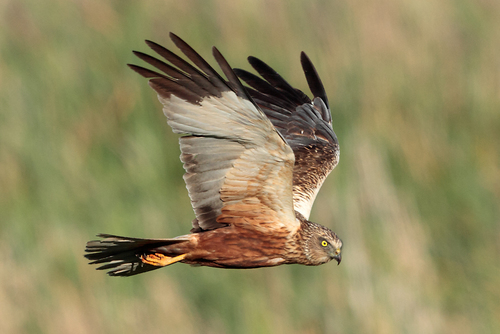
Western Marsh Harrier
The Western Marsh Harrier (*Circus aeruginosus*) is a large, elegant raptor renowned for its graceful, low-altitude flights over wetlands and reedbeds. It plays a crucial role in its ecosystem as a top predator, controlling populations of small mammals, birds, and amphibians. While not holding particular cultural significance in many areas, it's often seen as a symbol of wild, untamed wetlands and is admired by birdwatchers for its distinctive hunting style and striking plumage differences between males and females.
43-54 cm
Length
115-140 cm
Wingspan
Least Concern
Conservation Status
Distribution
The Western Marsh Harrier has a wide distribution, breeding across Europe and Asia, extending from the British Isles and Iberia eastward to Central Asia and parts of Siberia. It also breeds in parts of North Africa. Northern populations are migratory, wintering in sub-Saharan Africa and South Asia. Altitudinal range varies, occurring from sea level to around 2000 meters, though typically lower.
Lifespan
The typical lifespan in the wild is not well documented but is estimated to be around 8-12 years. Captive birds may live longer.
Western Marsh Harrier's Habitat
Habitat Types
Freshwater marshes, Reedbeds, Wet grasslands, Agricultural fields (during migration and winter), Coastal wetlands
Climate Zones
Temperate, Mediterranean, Continental
Adaptations
Their long legs and sharp talons are well-suited for catching prey in dense vegetation. A facial disc, similar to that of owls, helps them locate prey by sound in the thick reeds. Their broad wings allow for slow, buoyant flight while hunting.
Variations
Two subspecies are generally recognized: *C. a. aeruginosus* (Europe, Asia, North Africa) and *C. a. harterti* (northwest Africa). *C. a. harterti* is slightly smaller and darker.
Appearance
Breeding Plumage
There is little difference between breeding and non-breeding plumage, but juveniles differ significantly.
Seasonal Feather Changes
Minimal seasonal variation in adult plumage.
Sex Based Plumage Differences
Males have a striking combination of grey, brown, and black plumage with pale grey wings and tail. Females are mostly dark brown with a creamy-yellow crown, throat, and leading edge of the wing. Juveniles resemble females but are typically darker.
Notable Features
Long, broad wings held in a shallow 'V' during flight., Long legs and tail., Distinctive facial disc., Prominent white rump patch in females.
Diet and Feeding
Primary Foods
Small mammals (voles, mice), Small birds (nestlings, fledglings), Amphibians (frogs), Reptiles (lizards), Large insects, Occasionally fish
Foraging Behavior
The Western Marsh Harrier typically hunts by flying low over marshes and reedbeds, using its keen eyesight and hearing to locate prey. It often quarters back and forth over a small area, dropping suddenly onto unsuspecting prey.
Specializations
The facial disc mentioned earlier aids in sound location, particularly useful in dense vegetation. Their long legs and sharp talons are perfectly adapted for snatching prey from the ground or water.
Seasonal Diet Variations
Diet may vary slightly depending on prey availability. During the breeding season, they may take more bird chicks, while in winter, they might rely more on small mammals.
Behavior
Social Structure
Generally solitary or found in pairs during the breeding season. They may form small, loose groups at roosting sites outside of the breeding season, especially during migration.
Communication
A high-pitched 'kee-kee-kee' call, often used during courtship., A 'chattering' call used as an alarm., Visual displays, such as the 'sky-dance'.
Migration
Northern populations are migratory, undertaking long-distance journeys to sub-Saharan Africa and South Asia. They typically migrate in broad fronts, often following coastlines or mountain ranges. Migration is triggered by decreasing day length and food availability.
Territorial or Group Behaviors
During the breeding season, they are strongly territorial, defending their nesting area from other harriers and potential predators. Outside of the breeding season, they are less territorial and may tolerate other individuals at closer distances.
Conservation
Threats
Habitat loss and degradation (drainage of wetlands), Pesticide use (affecting prey populations and potentially direct poisoning), Persecution (illegal shooting and trapping), Collision with wind turbines, Climate change (altering habitat suitability)
Protection Programs
CITES Appendix II (regulates international trade), EU Birds Directive (provides legal protection within the European Union), Various national and regional conservation programs focused on wetland restoration and protection.
Local National Laws
Protected under various national laws in many European countries.
Population Trend
Generally stable, although some populations have experienced declines in the past.
Population Estimates
The global population is estimated to be between 240,000 and 410,000 mature individuals.
Interesting Facts
They can hover, albeit briefly.
While not as proficient as kestrels, they can hover for short periods while searching for prey.
Females are significantly larger than males.
This size difference, known as reverse sexual dimorphism, is common in raptors and may be related to the female's role in defending the nest and incubating eggs.
They are known to drown their prey.
If they catch prey in the water, they may hold it underwater until it drowns.
Polygyny is common in this species.
Males may have multiple female partners in a single breeding season, especially in areas with abundant food resources.
Faqs about Western Marsh Harrier
What is the difference between a male and female Western Marsh Harrier?
Males are grey, brown, and black, while females are mostly dark brown with a creamy-yellow crown and throat. Females are also much larger.
Where can I see a Western Marsh Harrier?
Look for them in wetlands, reedbeds, and marshes across Europe, Asia, and parts of Africa. They are often seen flying low over these habitats.
Are Western Marsh Harriers endangered?
No, they are currently classified as Least Concern by the IUCN, meaning their population is relatively stable.
What do Western Marsh Harriers eat?
They eat a variety of small animals, including voles, mice, small birds, frogs, and insects. They are opportunistic predators.
Copyright @ Nature Style Limited. All Rights Reserved.
 English
English